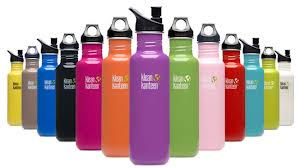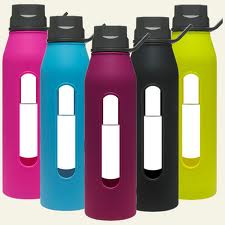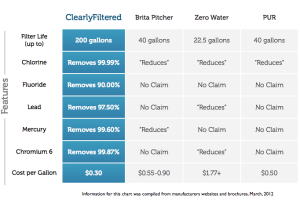Week 4: We started carrying water bottles with us everywhere.
Klean Kanteen Stainless Steel Water Bottle – This is one of the two water bottles we take wherever we go so we always have water. I keep mine in my purse and drink it all throughout the day. I send them to school with my kids in their lunches. They even make one with a sippy cap! Another option is the Klean Kanteen Wide Mouth Insulated Loop Cap, which keeps hot drinks hot and cold drinks cold. These bottles contain no BPA, phthalates, lead, or other harmful substances. “Always choose glass or a stainless steel bottle. Soft plastic bottles contain a number of harmful elements such as the carcinogen di-2-ethylhexyl-adipate (DEHA) and bisphenol-A (BPA), a known endocrine disruptor. Studies do indicate that there is a leaching potential, especially when hot water is involved, as the heat can encourage the plastic to off-gas, and in the bottle, the off-gassing vapors have nowhere to go other than directly into your water.” -Dr. Alejandra Carrasco
Even if they are BPA-free, plastic water bottles are still made of chemicals, which could potentially cause health problems.
Another type of water bottle we use and love are Takeya Glass Water Bottles with Silicone Sleeves. These are great if you like a dishwasher safe bottle — the stainless Klean Kanteen bottles are dishwasher safe, but the company recommends hand washing the ones that are colored. The Takeya Classic Water Bottle features a high quality glass bottle with a wide mouth, and is encapsulated by a silicone jacket that provides a nice grip, as well as protection for the bottle. The sleeve has a see-through window for checking the liquid level. The twist-off cap is airtight and includes an easy carry loop. This H2O bottle provides healthier way to drink, and eliminates metallic or plastic tastes, and leaching from toxic plastics.
People often ask me if the bottle is breakable when they see me with it. I actually tested the bottle when I first purchased it by dropping it on asphalt — it did not break! The silicone jacket really does protect the bottle.
Since we started our journey, we predominately drink water. Juice boxes and juice were one of the last things we removed from our house. I slowly weaned my kids off juice by adding more and more water to their orange juice every morning. One morning I just stopped giving them juice. They asked for it for a few days and now it is not even a topic of discussion. If we wake up early enough I will sometimes make fresh squeezed orange juice with a small juicer we have. Here is some information on the orange juice I was giving to them every morning:
“Even if they are “natural,” fruit juices are not that good for you. While they contain healthy components such as flavanoids and vitamin C, the sugar load is simply too great for the benefit. Small servings of two to four ounces are generally fine, but more will trigger blood sugar consequences. Soft drinks, especially carbonated, are incredibly unhealthy mostly due to added sugars, high-fructose corn syrup, colorings, and the extreme acid challenge from the carbonic acid carbonation.” – William Davis, MD
Making sure you have enough water during the day is essential to your health. If you do not drink enough water daily, you will feel tired. You will feel hungry because your body thinks it needs food for energy. Dehydration is the underlying cause of many diseases and ailments such as back and neck pain, stress, high blood pressure, high cholesterol, diabetes, asthma and allergies, arthritis, colitis and constipation, heartburn and hiatal hernias, gastritis and ulcers. Dehydration symptoms include constipation, thirst, dry skin, a sluggish feeling, dizziness, dry eyes and decreased urine output. Here are some recommendations from Dr.F. Batmanghelidj, author of Your Body’s Many Cries for Water:
The following tips will help you ensure that you drink enough water each day and avoid the disastrous effects of dehydration described above.
- Every day, aim to drink as many ounces of water as half of your body weight in pounds. If you’re currently drinking much less water than this, increase your intake gradually.
- Although dehydration can significantly compromise your health, drinking poor quality water poses serious risks as well. Be sure to drink high quality filtered water. The Clearly Filtered Clean Water Pitcher
has the most advanced filtration available for the price, with a patented anti-flouride technology.
Click here to find the water filter that will work best for you.
- Use the following schedule to achieve your daily water intake requirements in optimal fashion.
- Drink a glass of water immediately upon waking up in the morning. This will help to replace the water lost during sleep.
- Drink a glass of water a half hour to 15 minutes prior to each meal. This will help to restore the water used by digestion.
- Drink a glass of water between 1 and 2 hours after a meal. Drinking water too soon after a meal will dilute stomach acid and interfere with digestion.
- Because a cell’s ability to absorb water is dependent on salt, it’s one of the most essential nutrients to good health (see how we revamped salt in Week 5 of my Getting Started section). As such, it’s often beneficial to add a pinch of salt to your drinking water, but be sure to use good quality salt (i.e. Himalayan Pink Salt) instead of refined table salt. If you drink water that is filtered by reverse osmosis, the sea salt will also reduce the acidity of the water and replace lost minerals and trace elements.
- Because alcohol suppresses vasopressin, the hormone that facilitates water absorption by cells, it is best to limit its consumption. Furthermore, because alcohol is a toxin, additional water is drawn from the body to process and eliminate it.
Here is a visual guide to help you determine if you are drinking enough water:
To receive daily health tips and gluten-free, grain-free, dairy-free and sugar-free meal/snack ideas, like us at www.facebook.com/wholefoodrealfood.
“When you know better, you do better.”




Pingback: A Real Food Beginning | Whole Food. Real Food. Good Food.